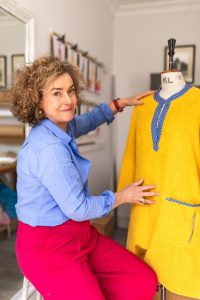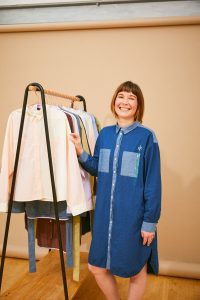- The team at TechRound has collected industry expert predictions on what 2022 will bring for the fashion industry.
- The COVID-19 pandemic has impacted, and continues to impact all major industries – but how has this affected fashion trends?
- Here, we explore the predictions for what is to come for fashion in 2022, with opinions offered from a variety of experts in the industry.
2021 has brought a variety of changes to the fashion industry, with the Covid-19 pandemic meaning more and more people have been trading their work suits for loungewear sets. But what will this mean for 2022? Here are our experts’ predictions for the upcoming year!
Our Experts Include:
- Lucy Jeffrey – Founder of Bare Kind
- Michaela Vybohova – Founder of Michaela V
- Sophie Slater – Founder of So English
- Karishma Gupta – Founder of Satatland, Ownership Free Circular Fashion
- Nikita Karizma – Founder of Karizma Design
- Jade McSorely – Co-Founder of LOANHOOD
- Antonia Johnstone – CEO of Sign of the Times
- Harriet Saywood Bellisario – Founder of Saywood
- Elle L. – Music Artist, Regenerative Fashion Ambassador, Kindness Champion for UNESCO MGIEP
- Abbey Gregg – Founder of Alyda
- Thandi Ojeer – Founder of Tandi Fashion
- Catarina Oliveira – CEO of Hey Harper
- Alona Shelemy – Founder of BY ALONA
For any questions, comments or features, please contact us directly.

Lucy Jeffrey – Founder of Bare Kind

I am noticing a shift in consumers holding companies to a higher level of accountability. For the most part the general public are mortified by some of the actions of these large fast fashion chains and will refuse to shop with them. We keep saying that we are seeing the ‘rise of the conscious consumer’ but I don’t think it has completely happened yet.
Where we donate profits to charity, and I know other companies do the same, customers are starting to think that this could be the standard. If Bare Kind donate 10% to charity why can’t others? So I hope we can continue to see the shift of companies towards setting a positive impact as a goal.
Michaela Vybohova – Founder of Michaela V

We are living in an incredibly exciting time full of changes. We keep hearing about major brands running to become a part of metaverse, creating digital collections, opening stores and this is only the beginning for 2022.
My second prediction for this year is that we will see almost every e-commerce retailer enable a live shopping experience via video, it’s becoming a hit with customers and it will keep growing.
Oh, and we can’t forget the NFT space, it started as something only tech nerds understood but as luxury brands are embracing it and releasing their own tokens, this won’t be going anywhere although I wasn’t huge fan at the beginning. I live by: “if you can’t beat them, join them.”
Sophie Slater – Founder of So English

One of the key trends on the rise is shopping smart and small. More popular than ever, the customer is seeking sustainable options and supporting small independent businesses.
The colour trends for 2022 are vibrant with “Shoppers reaching for shades of green to add pops of colour into their homes and wardrobes,” Etsy trend expert Dayna Isom Johnson says.
Colourful prints are trending with artsy motifs and retro florals, keeping the vintage prints fresh and worn in a modern silhouette such as a hoodie or shift dress.
Karishma Gupta – Founder of Satatland, Ownership Free Circular Fashion

2022 looks really interesting for Fashion industry and will set course of how next 10 years will look like. As we are now 2 years into the pandemic, the way we live our lives has completely changed which directly impacts how we consume fashion. The threats of new variants is not over yet and it will continue to disturb supply chains and push for increased product prices or lower margins for retailers.
Circular business models such as renting and resale will thrive in the current climate, as we do not necessarily need to produce more. Customers and businesses can get more value out of one single product rather than stuffing up their wardrobes and inventories. This will have significant positive impact on our planet as we are due to reach resource scarcity fuelled by climate change.
We also need to have right conversations in fashion about our impact on planet. I’d recommend to be cautious about the greenwashing of clothes on resale platforms made by ultra fast fashion brands. This will be a major conversation in 2022.
We really need to look at fashion holistically on how we produce, sell, consume and dispose clothing which is our top priority at Satatland.
For any questions, comments or features, please contact us directly.

Nikita Karizma – Founder of Karizma Design

The fashion industry is going through a phase of disruption. Through the pandemic there are a lot of flaws in the system that are coming to surface. It was a time of change for many. With the fall of fashion week there has been a question of how relevant the fashion show and fashion week is. Does the old format of showcasing designers still work?
Tiktok has become the go to platform for digital growth, many young studios and luxury houses are now focussing their efforts to reach out to Gen Z using video format. Burberry printed their logo onto pasta to create ASMR cooking videos which was a smart move to work with the Tiktok algorithm this week, I think it will be interesting to see how brands evolve with their digital media strategy in the Tiktok era and with Instagram’s focus shift to short form video.
There is a lot of interest in consumers loving to see content from the founders of businesses. Traditionally fashion designers tend to steer away from too much personal brand content but I think this year there could start to see a shift with more designers wanting to take you behind the scenes with video format to release more content and allow their customers and community to feel an emotional connection with you as a human.
Limited edition small drops with brand collaborations will grow this year, I think this has been spearheaded by a lot of celebrity owned fashion businesses developing their businesses in this way. It also has the appeal to create a viral buzz digitally and a strong call to action to shop before it’s gone online which can lead to brilliant cashflow and leads for a brand.
Jade McSorely – Co-Founder of LOANHOOD

2022 will be the year for action. As the pandemic forced the fashion industry to adapt and be creative, and quickly, this has only encouraged the industry to take more action and less talk. Sustainability has been a looming issue which the fashion industry still drastically needs to address, but as larger companies struggle to change, we predict we will see an influx in new, innovative startups that are creating a new fashion landscape that is more community-orientated.
The sharing economy and resale will grow exponentially and fashion will adopt new technologies to combat the environmental impact of fashion. A new generation of co-founders, designers, innovators and creators won’t be afraid to step outside the traditional systems. Industries will no longer work in silo but blur together and unlock new potential and audiences. Our digital identities will be dressed in digital fashion, opening up the metaverse to fashion consumers.
What we are excited about at LOANHOOD for 2022 is how the sharing economy will empower the consumer, giving the entrepreneurial mindsets of Gen Z and Gen Alpha a platform for disruption and to take back control of their own buying/non-buying power. There is a wave of new consumers that are digitally and environmentally conscious that will become part of the industry and not just passive consumers.
Antonia Johnstone – CEO of Sign of the Times

Conscious consumers are driving the growth of luxury resale exponentially. With shoppers becoming more aware of the implications of their purchases, the current waste crisis beleaguering the fashion industry and an increased commitment to living sustainably, this trend is only set to continue on an upward trajectory as we head into 2022.
As someone with over a decade’s worth of experience selling the unwanted luxury wardrobes of affluent individuals in London, and with a tech-led approach via our stock system, e-commerce and WhatsApp channel, it has been interesting to see the explosion in demand for pre-loved designer items since the pandemic hit.
With supply chain issues caused by Covid-19 and Brexit these past two years, consumers who may not have turned to pre-loved luxury before have been to get their hands on luxury goods from sellers rather than hard-hit manufacturers.
Now they have tried – and loved – shopping timeless designer pieces this way, it has shifted luxury shopping habits and paved the way for a bourgeoning luxury resale market for good.
As well as fundamental supply chain issues preventing new luxe items getting into the hands of buyers, retail closures have meant more people are turning to e-commerce to make big-ticket purchases, including vintage investment pieces.
In part driven by Gen Z who quickly adopted selling and buying fashion via peer-to-peer resale platforms, older consumers in the 25-39* bracket are now getting on board. So much so that Sign of the Times’ online searches increased 81 per cent between 1st January – 20th October 2021 year-on-year.
Luxury resale will continue to become a larger segment of fashion retail as consumers endeavour to make big or small planet-friendly changes. In 2022, the luxury shopper has the power to drive the pre-loved market forward with exceptional designer product, which has the durability and craftsmanship to support circular lifestyles for many moons to come.
Harriet Saywood Bellisario – Founder of Saywood

2022 could be the year that brings us the natural slowing down. Following two years of the pandemic, we may be seeing consumers slowing down their shopping habits, whether they are making a conscious decision to or not. Whilst high streets were on a slow decline pre-pandemic, heading for an evolution of sorts, two years of a pandemic may have embedded in shoppers a naturally slower pace. Whilst shopping hauls may not have reached ground zero yet, far from it, could shoppers subconsciously slowly be starting to move towards demanding more from what they buy.
Versatility will be the name of the game; buying less but buying with purpose. 2022 is all about the versatile wardrobe that works for the wearer. Learning to understand our personalities and our own style is the best route forward, and we’ve had time to understand what we love wearing. And with such a volatile environment of inter-changing seasons, working from home or office, going out or going somewhere, we need our wardrobes to be flexible; versatility is how our wardrobes will work hardest for us, and the past two years have impressed this upon us.
Whilst people will still likely be after a bit of a refresh, there will still be so many of our clothes that feel new to us again, having not had as much of an out-and-about 2021 as we may have hoped for. Getting fully dressed maybe less often for a second year running will have given us more time to understand the clothes we really love to wear in our wardrobes, our go to pieces, and with that the understanding of what we will look for the next time we shop. The past two years have been mentally intensive, 2022 wants to feel a little lighter. Fashion is the last thing we need to be complicated. Those pieces that go with multiple things in our wardrobe are the pieces that will make getting dressed a breeze.
For any questions, comments or features, please contact us directly.

Elle L. – Music Artist, Regenerative Fashion Ambassador, Kindness Champion for UNESCO MGIEP

When it comes to fashion as art, I believe the future of the industry will become multi-sensory and integrate both digital and physical forms of expression. I recently saw a piece called Universal Everything at 180 The Strand’s Lux exhibition of immersive art. Whilst not strictly fashion, it moved me emotionally as it took us through an ever-looping and evolving ‘transfiguration’ of elements that were very much like an evolving wardrobe of sound, colour and texture.
I could truly see how we will start to innovate ideas that never before existed through the use of 3D imaging. Designers like Patrick McDowell are already embracing this, with fully Digital collections like ‘Catholic Fairytales’, where a ‘Queer city in the digital clouds’ was created for Milan Fashion Week at the beginning of the pandemic in 2020. If Alexander McQueen were alive today, I could imagine he would also be innovating and embracing a digital disruptive form of moving fashion into a new and beautiful direction. If we can use digital technology to elevate our imagination and reconnect fashion to nature in inventive ways, I think the future of fashion and trends for 2022 can become limitless.
When it comes to utility, I believe society is becoming more mindful about our purchase power, but we still need to get rid of toxicity in the system at all levels. That requires full transparency and responsibility from both creators and buyers. Brands need to provide a traceable passport, similar to the food index we see on our products, so our clothes give us full disclosure on the source of everything we own. I’m not sure how we can truly identify the impact our purchase will have on the climate if we don’t embrace this technology.
Of course, we still need to ensure the entire textile supply chain is respected, paid fairly and on time. We also need to use more natural dyes, choose organics where possible and avoid synthetics and reduce waste. If we can give more importance to the soil in terms of regenerative ways of sourcing and choosing biodynamic suppliers, we can really start to make progress and reverse the trajectory that we are headed. Our fashion should never be thought of as ‘single-use’ or ‘one-wear’, we should become more innovative with how we rewear and restyle. In fact, healthy fashion will have many life cycles beyond our own and be fully compostable when it goes back into the land that it originally came from. Our wardrobe may be more timeless but it will mean far more than throwaway toxic clutter.
There’s a cost in preventative fashion but there’s a far greater cost in curative fashion. If we don’t act now, it really is far too late. Through collaboration, there’s an even greater opportunity to create change. We are at the precipice of something new and I hope that the change we create is something truly remarkable and inclusive for us to be a part of. The future of fashion is only going to protect its own future by being boldly transformative. I hope the fashion industry embraces multi-sensory forms of innovation and becomes more inspired by and respectful of nature.
Abbey Gregg – Founder of Alyda

The turmoil experienced over the last two years has presented countless challenges within the industry, from wavering customer demand and loyalty to supply chain disruptions due to raw material availability and transportation barriers. These challenges are expected to remain in the year ahead, potentially affecting business growth. Therefore, the ability to remain agile is more crucial than ever.
As the environment evolved around us, this has brought a noticeable shift in consumers mindsets. More disposable clothing is losing its appeal, and people are now looking to consume more consciously and make purchasing decisions that have positive social, economic and environmental impacts. These consumers are more inclined to invest in higher-quality pieces that stand the test of time. Purchasing clothes with longevity in mind has a more positive environmental impact, as extending the life of clothes by just nine months, reduces carbon, water and waste footprints by 20 – 30 per cent. Also, consumers are purchasing smarter, considering the return on investment for each garment purchased; for example, this could be a financial return through future reselling or renting contributing to the circular economy.
Overall, the rise in conscious consumerism means consideration in incorporating sustainable strategies is vital for brands not to get left behind. As a newly launched brand, our plans for this year are to grow our product range and continue to expand on our sustainable initiatives (for example, by sourcing more sustainable, innovative materials). In addition, we are increasing investment into the brand, social media and omnichannel shopping experiences.
Thandi Ojeer – Founder of Tandi Fashion

Main trends globally will revolve around a common theme; fashion that demands to be seen.
Recovery in the sector since the beginning of Covid, is showing positive signs with 2022 being the year to re-emerge. Not only is there a revived feeling, but an enhanced joy in getting dressed up today. Most brands, I reckon, will focus on looks, designs, and colours that magnify and empower women, and make the customer feel positive and true to themselves and what they value. Looks will revolve around regaining power, momentum and sexuality in a way that works for the individual.
This is why we at Tandi Fashion put a lot of thought and effort into using fabrics that flatter all sizes, and use classic cuts yet bold colours to engulf the ‘sexy back’ wave post Covid. Taking pride in ones attire is now a top agenda for all designers. Shoe designers will also look to do the same, with heels coming back in full effect to compliment the fabrics that lay on the body. After being confined to our homes more than anyone anticipated, everyone is now ready to rise like the Phoenix in ways that speak loud, sexy, bold, confident, and empowered without uttering a single word!
Catarina Oliveira – CEO of Hey Harper

Regarding jewellery trends for 2022, I would say that introducing new colours beside gold and silver is the biggest one – whether it is the full piece or just details, with enamel and crystals being the chosen materials. We are going to see a lot of colours mixed with the classic gold and silver.
2022 is also going to be the year where we must become fully transparent with our customers and business partners regarding how we do materials sourcing, what are exactly the components of our pieces, sustainability practices we have adopted and our supply chain. The customers and partners want to know exactly who and where we produce our pieces, if they are recyclable, or what we are doing as a brand to improve the planet we live in. And they want evidence. To say that we are sustainable is not enough to show that we are having a positive impact on the planet – Greenwashing is a term that has been talked about a lot, so we have to be really clear on how we do our business to avoid misconceptions.
Even though we are still in pandemic times and e-commerce has grown exponentially, I truly believe there still is a huge potential in physical retail as an opportunity to create unforgettable experiences. Being a CEO of a brand that sells 95% online, it’s becoming more challenging to offer memorable experiences that distinguish us from our competitors. We can offer next day delivery, free shipping, free exchange and returns, personalisation, but so every brand on the marketplace. I believe that very specific retail experiences will be essential to create deeper connections.
Alona Shelemy – Founder of BY ALONA

My trend predictions for this year with fashion are that people are looking for more fun with their wardrobe. A touch of colour can add a fresh or happy aesthetic to your look, and that ca be added easily with jewellery as well. A great way to add colour with jewellery is with semi-precious stones, they give beautiful natural colour and quality as well certain stones are believed to have positive impacts on the wearer.
Another trend is buying less but better quality. We all want to do our bit for the planet and re-use and re-wear nice quality pieces are a win win. I also believe the clothes rental market will grow, apps such as by rotation and Hurr make it easy to do this and give you a fresh wardrobe at the fraction of the price.
Overall I think people are looking to feel positive after the last couple we have had. We have even launched a whole collection with the latin phrase ‘Ad Astra, Per Aspera’ which means ‘Through adversity, to the stars’ acting as a reminder to keep on the positive path and anything is possible.
For any questions, comments or features, please contact us directly.




